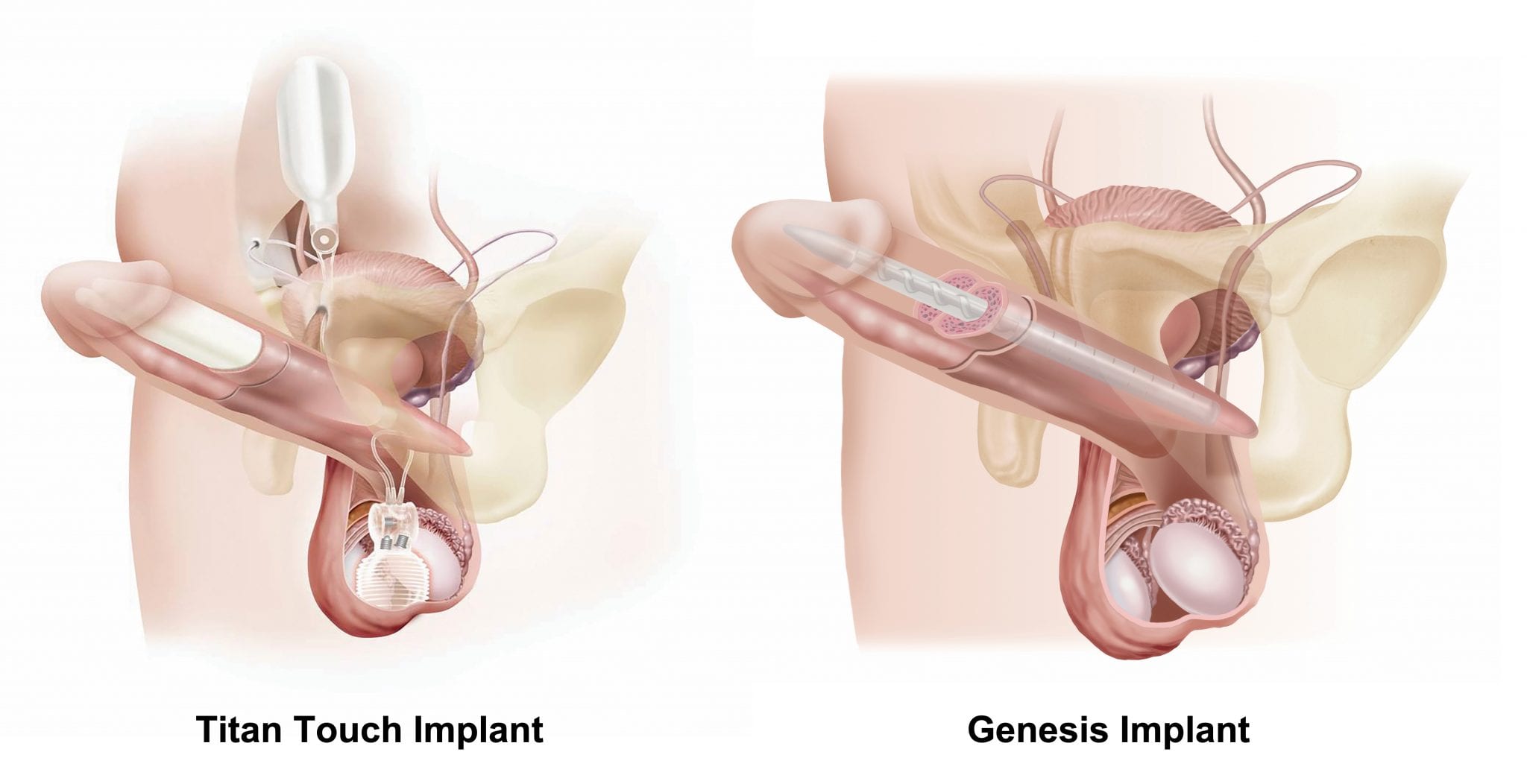Penile Implant, Chattanooga TN

Common medical conditions where an implant is indicated include peripheral vascular disease, renal failure, diabetes types 1 & 2, pelvic trauma, and when ED is a side effect of prostate surgery or cancer treatments. Come visit Dr. Shrid in Chattanooga, TN for evaluation and treatment options, we also see patients from Knoxville, Northern Georgia & Huntsville, AL.
What is a penile implant?
It is a device that is implanted inside the penis to allow men with erectile dysfunction to achieve erection. A penile implant is recommended when all other treatment options have failed to provide an erection sufficient or satisfactory for sexual activity.
What are the benefits of a penile implant?
Penile implants provide the most reliable erection for men who have failed medical therapy. Studies indicate that this reliability can lead to a high level of satisfaction (88-95%) and enhanced psychological and emotional well-being from the benefits of a penile implant. Of equal importance, partners of men with an implant are almost equally satisfied with the device as well. An implant will not change sensation, affect ejaculation or the ability to reach orgasm. The implant can stay erect as long as the individual chooses it to be that way. The implant is completely concealed within your body and even some medical providers cannot recognize when the device is in place on physical exam.
Choosing the implant type
It is difficult for the patient to determine which device is best for them without help from an experienced urologic surgeon. Many factors should be considered when choosing the implant. This includes your age, penis length & girth, whether penile deformity or curvature exists, any previous abdominal surgery, your hand function to operate the implant and your overall health.
Dr. Shridharani will discuss with you the potential implant options and your preferences. The exact type will be determined prior to the procedure, although in rare instances the device may be changed in the operating room to best suit your needs. The length of the implant is determined at the time of placement and is based on internal measurements of the penis. The objective is to optimize rigidity by selecting implants with the longest inflatable portion and to maximize the length and girth of the penis shaft.
What types of implants are available?
Generally there are two types of implants:
- Semi-rigid, or malleable devices consist of bendable rods implanted into the erection chambers of the penis and can bend as needed for penetration. This type is easy to use by simply bending it up for an erection and down when not in use. It is a good option for men with limited dexterity. It is the least expensive option and the surgical procedure is less involved than the inflatable implant. The disadvantages with the malleable prosthetic are that the penis must be adjusted for a constant erection, the penis is always semi-rigid, and has an abnormal feel and appearance. Dr. Shridharani usually implants this device in men with poor hand function, men who do not like the idea of moving parts within the device, individuals who are not likely to be healthy for another procedure if the device fails, men with prolonged untreated priapism and for salvage procedures after implant infection.
- Inflatable devices are the most common type of device implant and lead to the most patient and partner satisfaction. Inflatable cylinders are implanted in the erection chambers of the penis with a pump in the scrotum for patient activation and deflation. They are filled with saline solution(salt water) and a reservoir is placed in the abdomen where the fluid is stored. Generally they allow an erection whenever you choose, are easy to conceal and look and feel more natural.
- There are two subtypes: Three-piece inflatable implant: It is easy to use and the pump and reservoir are larger and softer than the two-piece, making it easier to inflate. The reservoir is usually implanted behind your abdominal wall or behind your groin muscles. This type is the only implant available that gives the penis a natural appearance and feel when erect or deflated and preserves sensation and orgasm. It provides enhanced sexual endurance and creates a penis that is usually larger, wider and longer than it was before the procedure. Nevertheless, the idea that it will be the same length after implantation as it was in a man’s 20’s is unlikely. Two reasons why this may not occur are due to the increased fat above the penis that increases as men age and scarring within the penis due to longstanding ED that precedes implantation. The implant offers the opportunity for spontaneous sexual activity and has high patient and partner satisfaction. Malfunction rates are low, but the device lasts 10-15 years on average and may require replacement in one’s lifetime.
- Two-piece inflatable implant: These devices have the reservoir combined with the pump in the scrotum. Like the three-piece, these devices are easily concealed, easily inflated and an erection can be maintained as long as necessary or desired without risk of serious complications. The reservoir is small and may not provide an adequate erection for some. It is a good option where there is limited dexterity and is particularly useful in people with prior abdominal surgery who have no place to put the reservoir.
There are two brands that make penile prosthesis, Coloplast and American Medical Systems (AMS). There are multiple differences between the inflatable and malleable implants they make; however, both make exceptional products and offer very similar results with regards to rigidity, satisfaction and lifespan.
What can I expect if I have the implant placed?
Generally it is very successful, satisfactory and safe for most appropriately selected men. The surgical scar is hidden either above or below the penis and will not cause embarrassment. In most cases, Dr. Shridharani performs an infrapubic approach penile implantation with the incision located above the penis. This usually has less risk of significant scrotal swelling and may be associated with a higher satisfaction rate compared to an incision in the scrotum. A “keyhole” incision about 4 cm in length is the norm. The procedure is performed as a outpatient or with a 23-hour stay. Drains and a urinary catheter are placed temporarily to minimize the risk of post-operative swelling and inability to urinate.
Redo operations for malfunctioning devices or after implant infections usually entail different post-operative expectations. Dr. Shridharani will tailor the discussion about these procedures to your specific situation.
What are the risks of undergoing the penile implant procedure?
The usual risks of surgery are the same here. Post-operative pain, swelling, bleeding, wound issues, and infection are some of the most common risks. Implant infection usually requires removal; therefore, it is one of the most extensively studied risks of implantation. Multiple steps are taken to minimize infection by Dr. Shridharani, the hospital, clinic, and OR staff. Currently, Dr. Shridharani’s infection rate is about 1-2 out of 100 which is within the acceptable rate of high-volume prosthetic surgeons and experts internationally.
How long does the implant last for on average?
Since the inflatable prosthesis has parts that move within, it will wear out over time. The average lifespan for an implant is 10-15 years; however, the newer implants have not been around long enough to reliably assess their lifespan. Based on significant improvements to the devices over time, it is suspected that implants are become even more durable. Nevertheless, the amount of years the device can last is an average and predicting whether the device will fail within 5 years or after 20 years of use remains difficult.
Will my insurance cover the procedure?
Insurance is likely to cover the surgery where medical cause is established. However, certain insurers’ plans exclude any ED treatments. We will assist you in the process of assessing cost for the procedure. If you have high deductibles or your plan does not cover the implant, ask us about a discount and payment plan.
What determines whether I should undergo the penile implant procedure?
Dr. Shridharani will guide you through the process and assess whether you can undergo a penile implantation procedure. If you are not a candidate other ED treatments may be offered. Ultimately, the decision to undergo the procedure is based on the impact ED is having on the individual or couple. If undergoing the procedure would negatively impact the man or couple then it will not be done. The main purpose of doing the procedure is to regain or improve intimacy, normal sexual function and quality of life. Dr. Shridharani understands this core goal and will work with you to find the best treatment option for you and your partner.
What People Say About Us!
“Excellent office face to face visits and expertise with [penile] implant placement.”
– Al C, Ooltewah, TN
Click here to read more reviews.
Dr. Shridharani proudly serves Chattanooga and Knoxville TN, Northern Georgia, Huntsville AL and the surrounding areas with advanced penile implantation surgery. Call (423) 778-4MEN (4636) to schedule an appointment today!



